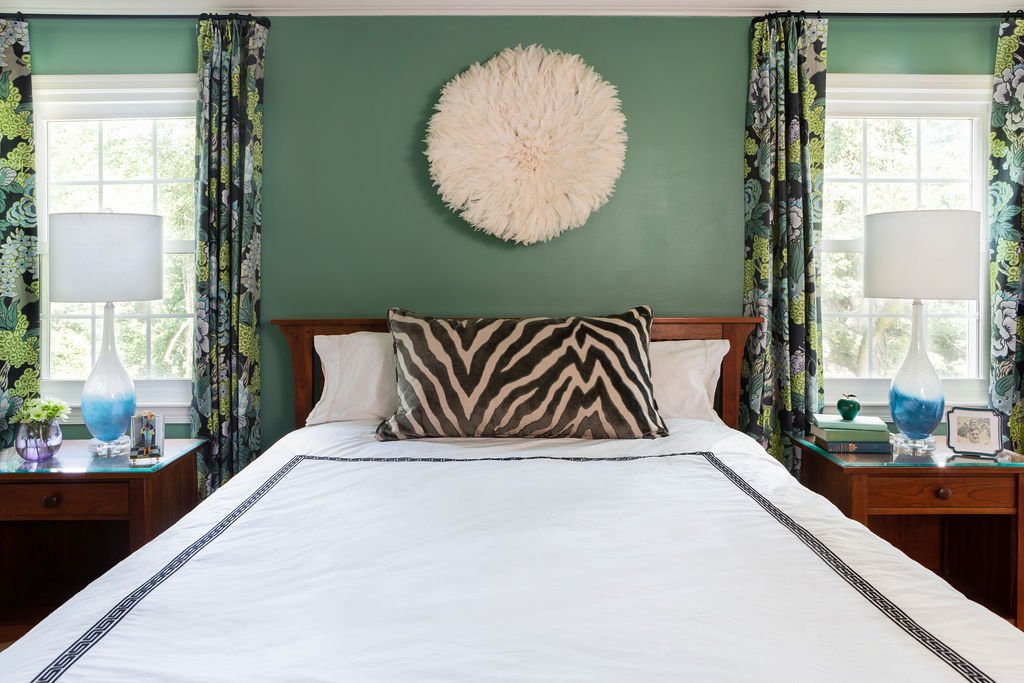So You Think You’re Ready to Paint Your Walls…
Paint should never be picked in a vacuum. Here’s what to consider before selecting the color that you’ll have to stare at for the next few years.
“What color should I paint my living room?,” is one of the top questions clients ask. They’re eager to select a paint color because getting something on the walls can feel like a huge step forward when you first kick off a design project.
But our response is always the same: Paint should not be the first step in design, because you can’t pick wall color in a vacuum. Choose paint first, and there’s a good chance you’ll end up repainting within a few weeks or months as you finalize furniture and fabric selections. Try to pick a safe neutral that will evolve with your decor, and you might find that the space never truly feels like home.
Paint is going to be the most significant color choice in any room. It can transform a space simply because it takes up the most square footage of any color in your palette. But that doesn’t mean that it should be the driving force in your design. It’s an integral part of the design, but it does not guide the design. Paint in the room is like the cover of the book. You can’t put the cover together until you know what the story says.
Instead, your paint choice should be guided by a series of questions we have curated for you here. You should start at the immovable elements, the lighting from windows and the floor color, and work your way in towards the must-keep furniture pieces and fabrics you’ve had saved on your Pinterest for months. Here are four questions to get your paint selection process started.
Questions to Ask Before Selecting a Paint Color
What type of light do you have?
When looking at light, you should consider both natural light and ambient, task, and accent lighting. A room with abundant natural light is going to reflect lots of light on its own and will automatically lift the mood of the room. A bright color in this space will reflect and intensify itself, while a darker color will provide contrast and depth to make for a more mature environment. The opposite is true of a room with darker lighting. Light-toned walls will warm up the space and lift the energy of the room, whereas dark colors will lean into and further emphasize an already moody tone.
When it comes to artificial light, it all depends on the light bulb you choose. Some give off a pink hue, others a warm yellow, and some emit a harsh white surgical light. Try to choose a paint color that contrasts the light bulb that you will typically have in your lighting. Balance warm with cool and cool with warm. The contrasting artificial light will help bring out the depth of color in your paint choice.
What is the natural landscape outside your windows?
The second part of light is how it reflects that natural landscape around you. Do you have a reflection from water or trees? Or is it bricks or stone? These exterior elements become part of your room when they are reflected back into your space. Work with these to choose your paint color. If you’re surrounded by trees, you should choose a paint color with a green undertone that will work nicely with your organic surroundings. If you’re by the water, then blue undertones will bring out the best light in your room. For brick and stone, a color with more neutral undertones will compliment the lighting the best.
What are the tones in the room?
Paint does not exist in a vacuum. It’s going to pick up the colors and tones around it. In your space, you may have hardwood floors or tile that you plan on keeping, or you’re in a kitchen where the countertops are staying the same. In these situations, you need to examine the existing tones within those elements, and let them guide the paint choice.
If you have warm oak floors, then you’ll want to choose a paint with warm tones. If you have gray floors, then you’ll look at cooler colors. But that doesn’t mean you’re stuck with oranges, rusts, and reds just because your existing tones are warm. Even colors like blue or green can have a warm undertone, and a red or orange can have a cool undertone. This is where it can help to enlist a professional who can steer you towards colors that are the right fit for your room.
A cool blue paint in this alcove echos the cool tones in the flooring.
What are your other design selections?
From your furniture to your accent pillows, the design elements within your space should come before the paint. Was there one print that inspired your room? A piece of art that informed your upholstery choices? Is there a color running through every decorative item you’ve been drawn to? Decide on these textures and fabrics first, then let those guide how you’re going to wrap the room in color to bring it all together. This tells the story of the room and the paint color sets the mood and bring the whole space together.
What to Do If You MUST Choose Paint First
While picking paint first is generally putting the cart before the horse, there are situations where a client may have a painter coming before move-in day, and they just need to choose something now. In these cases, the first three questions are still relevant. Those will help steer you towards a neutral that can inform the rest of the design process.
But, no, there’s no color that goes with everything. Even when you choose a neutral, keep in mind that the color that ‘goes with everything’ is a myth. Agreeable Gray and White Dove are wonderful colors, but they are not a magic fix.
You can paint two rooms in Simply White, but one room may be surrounded by lush green trees, while another looks out on a sleek urban landscape. In both of the spaces, the goes-with-everything white is going to pick up different tones and give the room a different personality.
Think of those designer-approved classic colors as a starting point, but use these questions to help narrow the selection down to the right color for your space. And, if you find yourself stuck, go with the paint color that you’re immediately drawn to — if you pick what you love, you will always love what you pick.
Green paint in a bedroom echoes the lush green foliage just outside.


